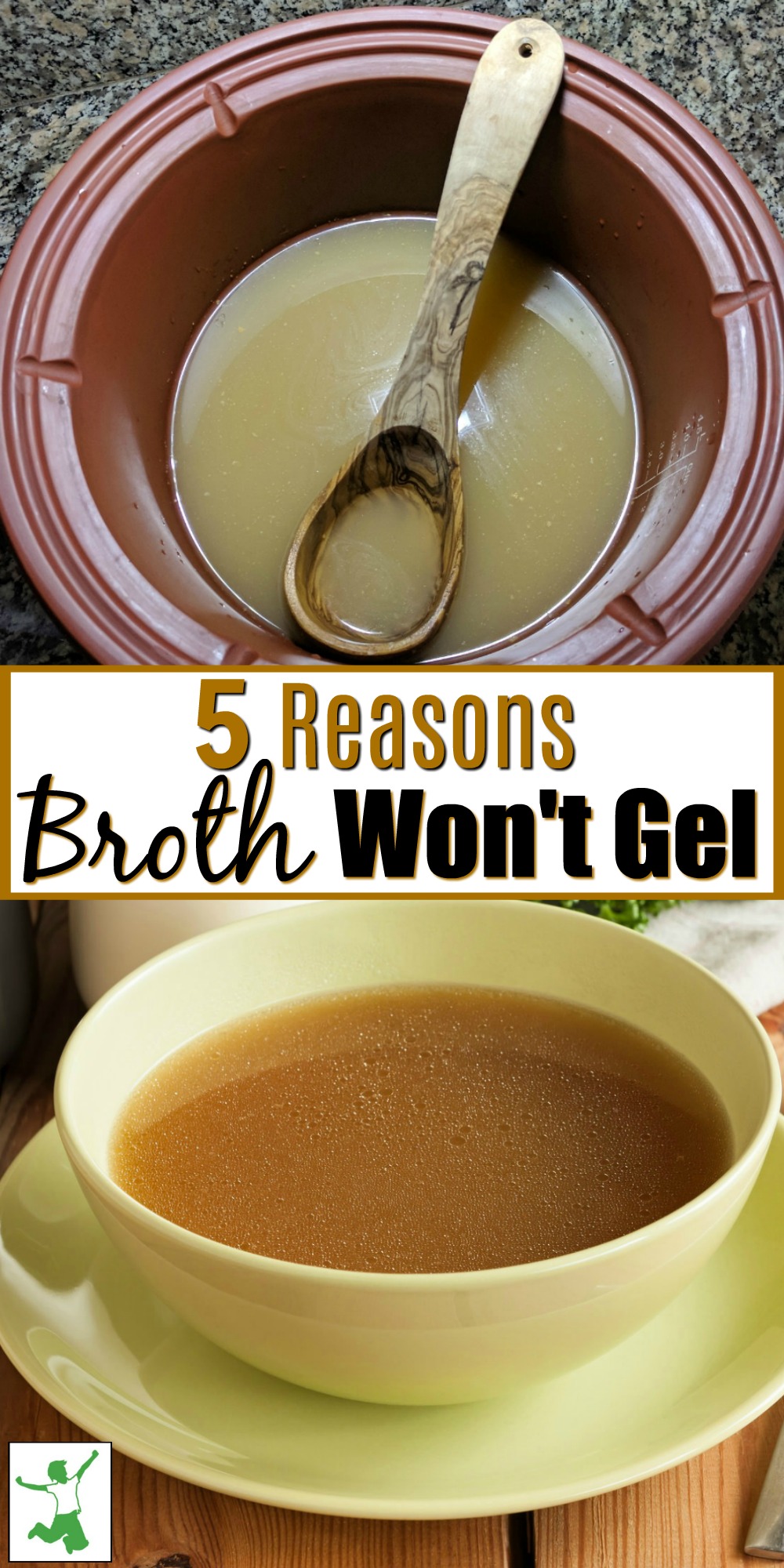
Do you have frequent trouble where your homemade broth doesn’t gel after being chilled in the refrigerator? This is a problem to solve quickly, as correct preparation is one of the foundational techniques of Traditional Cooking.
So critical is properly made, gelled homemade stock to the ongoing maintenance of health that Dr. Francis Pottenger MD, author of the nutrition classic Pottenger’s Cats, considered the stockpot the most important piece of equipment in the kitchen.
Homemade stock is so essential because it contains ample amounts of gelatin, a colloidal substance that attracts digestive juices to itself and prevents gastrointestinal bugs from attaching themselves to the gut wall and wreaking havoc. Natural gelatin both assists digestion and keeps you well!
In addition to gelatin, stock contains minerals such as calcium, silicon, sulphur, magnesium, phosphorus, and trace minerals all in a form that is incredibly easy for the body to absorb.
Do you take expensive supplements for joint pain or arthritis?
Simply adding homemade stock on a frequent basis to your diet will do your cartilage, tendons, and joints a world of good as stock also contains collagen, chondroitin sulfates, and glucosamine.
With homemade stock such a critical food to health, it is important to make it correctly. One sign that you have indeed performed the task well is that your stock gels beautifully once it is chilled in the refrigerator.
If you find that your stock won’t gel most of the time, here are the 5 typical reasons why as described by Monica Corrado, MA, CNC, and author of the blog Simply Being Well. Monica teaches cooking classes and does consultations, so be sure to check her website for this information if you could use some coaching.
Reasons Why Stock and Bone Broth Won’t Gel
- The stock rolled at too high a temperature. If stock or broth is simmered too high, the heat will break down and destroy the collagen. To see what the perfect simmer on your stock should look like, see my short video on the subject by clicking here.
- The stock did not roll long enough. Once you get that perfect simmer or “roll” going, be sure that chicken stock rolls for 6-24 hours and beef stock for 12-50 hours. Less than that will likely not draw enough gelatin into the stock from the bones.
- Not enough of the right kind of bones were used that yield gelatin. To get the right mix of bones that yield gelatin versus other types of bones that add flavor and color, make sure you use one of the following methods: 1 whole, free-range layer hen with neck and wings cut up, 3-4 lbs of boney chicken parts which includes a combo of necks, backs, and wings, OR the picked carcass of 2 meat chickens. For beef stock, use about 7 lbs bones total (4 lbs of boney bones and 3 lbs of meaty bones).
- Too much water was used in proportion to the bones. For chickens, the correct proportion is 3-4 lbs of bones per 4 quarts of filtered water. For beef stock, the correct proportion is 7 lbs of bones per 4 quarts of water or more to cover.
- Using bones from battery chickens or chickens raised in cages. Conventionally raised chickens or chickens raised in cages typically yield little to no gelatin. It is worth the extra money to get quality when you buy meat especially if you will be using those bones to make stock.
To get additional gelatin, add 2-4 chicken feet to the stockpot or even the head for even more! If your chicken is a rooster, add the comb. This will also add gelatin along with testosterone to the stock which adult men may find appealing as levels tend to decline with age.
Failsafe Solution If Your Stock Won’t Gel
If despite all your best efforts, you still come up with a pot of stock that does not gel, add 1 TBL of powdered gelatin per quart of liquid.
Vetted sources of good quality gelatin are available under the Supplements Section of my Shopping Guide.
Hopefully, these tips will help you solve the riddle of why your stock doesn’t gel so that the time you spend on this age-old culinary tradition is well spent producing the most nutrient-dense stock possible!

More Information about Gelatin
The Reason You Need More Gelatin in Your Diet
Gelatin and Collagen Hydrolysate: What’s the Difference?
The Benefits of Gelatin and How to Get More in Your Stock
Video: Stock that Gels!
More Information on Broth and Stock
How to Make Turkey Stock
The Healthiest and Best Bone Broth
How to Make Duck Stock
Rabbit Stock
How to Make Beef and Chicken Stock
How to Make Shrimp Stock
Confused about Stock versus Bone Broth?
The Perfect Simmer on Your Bone Broth








I made beef bone broth that didn’t gel. It just got very dark brown but was soooo good. I love having it. I guess I don’t understand what you mean by “meaty bones”. What would be considered a beef meaty bone?
I heard you with Sean Croxton and loved listening. Peace and blessings.
Do you know of any problem with making a TON of broth at one time? I have made 5 gallons of stock at once in my huge pot by using the Nourishing Traditions recipe. I try to keep the same ratio of water to bones and veggies. Also, I use a couple of pounds of heads and feet that I get from a local farm. Is it okay to use just as many pounds of heads and feet as the back and other parts? Lastly, I am so glad I saw your video on the perfect simmer. I have definitely heated mine too much in the past.
I was also wondering…if the stock didn’t gel correctly, would you still keep it and use it?
Thanks!
Oops- I meant to say post, not email. And I just tried boiling it down, as Sarah suggested in one of her follow up comments, but that didn’t work either. 🙁
Okay, just tried to make stock. total failure. I used organic chicken feet, an organic whole chicken, water to just cover chicken, just at a simmer like on the video. Did not gel at all, is kinda of brown and the chicken was horrible. Gave it to the dog, and even he won’t touch.
Beth, I read your email as I was making my stock yesterday. Mine didn’t gel at all, either, and I followed all the instructions. It never does, and I can’t figure out why!
Should fish stock gel?
Can you put wine instead of vinegar? I don’t care for the taste of vinegar in my stock, but Trader Joe’s sells some pretty good cheap wines (2-buck Chuck). I’ve been using that for years, hoping it has a similar effect to vinegar. If not, I could probably switch to lemon juice?
After you’ve simmered your stock for the appropriate amount of time, there should be no taste (or smell) of vinegar left in it.
Okay; I’ll try it on my next batch.
I guess we’ve been “lucky.” We accidentally came upon our formula for nicely gelled chicken stock. The bones and of 2 whole roasted chickens or 8 leg/thigh bones. Toss in a quarter of an onion, a few stalks of celery, a teaspoon of minced garlic and let in slowly boil for 2 hours. Then turn off the heat and let it set on the stove for 2 hours. Remove all the stuff and put in the fridge. Make soup right away or put in the fridge. Once it’s cooled use it in soup within a day or two or pour into freezer bags for the next time we need it.
Another caveat about using battery/caged chickens is that almost all of them are pumped full of a 12% to 15% “solution” of “natural flavors,” which is basically MSG!!!. I get migraines and avoid MSG like the plague. Ironically, many people who make homemade stock make it to avoid having to buy commercially made stocks that have no gelatin, but are also chock-full o MSG!
Thanks,
Joyce